Your cat loves basking in the sun, chasing butterflies through your garden, and investigating every corner of the yard. It’s adorable watching them explore their outdoor kingdom, but lurking among your beautiful flowers and shrubs could be silent threats to their health.
Many popular landscaping plants contain toxins that can cause anything from mild stomach upset to fatal organ failure in cats. The worst part? Some of the most dangerous plants are the ones we deliberately plant for curb appeal. Let’s uncover which common yard plants pose the biggest risks to your feline friends.
The Hidden Danger in Every Suburban Garden
Cats are naturally curious creatures, and unlike dogs who might devour an entire plant, cats tend to nibble, bat at leaves, or brush against flowers—which means even minimal contact with certain plants can spell disaster. Their grooming habits make things worse; pollen or sap that lands on their fur gets ingested when they clean themselves.
Outdoor cats face constant exposure, but even indoor cats who venture out occasionally are at risk. According to pet poison control centers, plant toxicity ranks among the top reasons for emergency vet visits during spring and summer months. The good news? Once you know what to look for, protecting your cat becomes straightforward.
1. Lilies: Even the Pollen Can Be Fatal
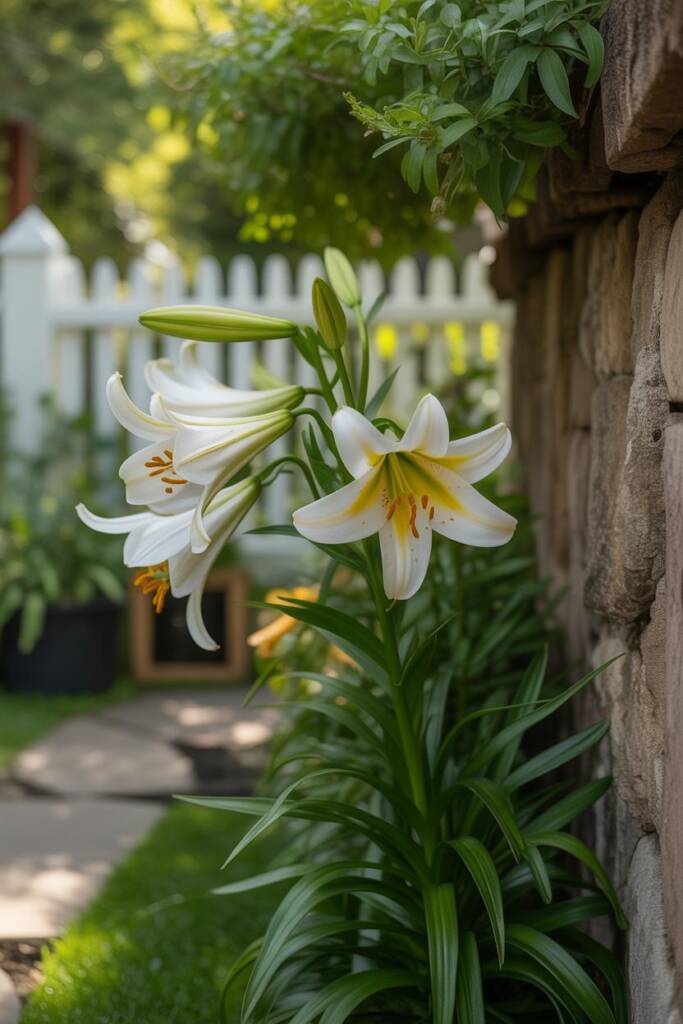
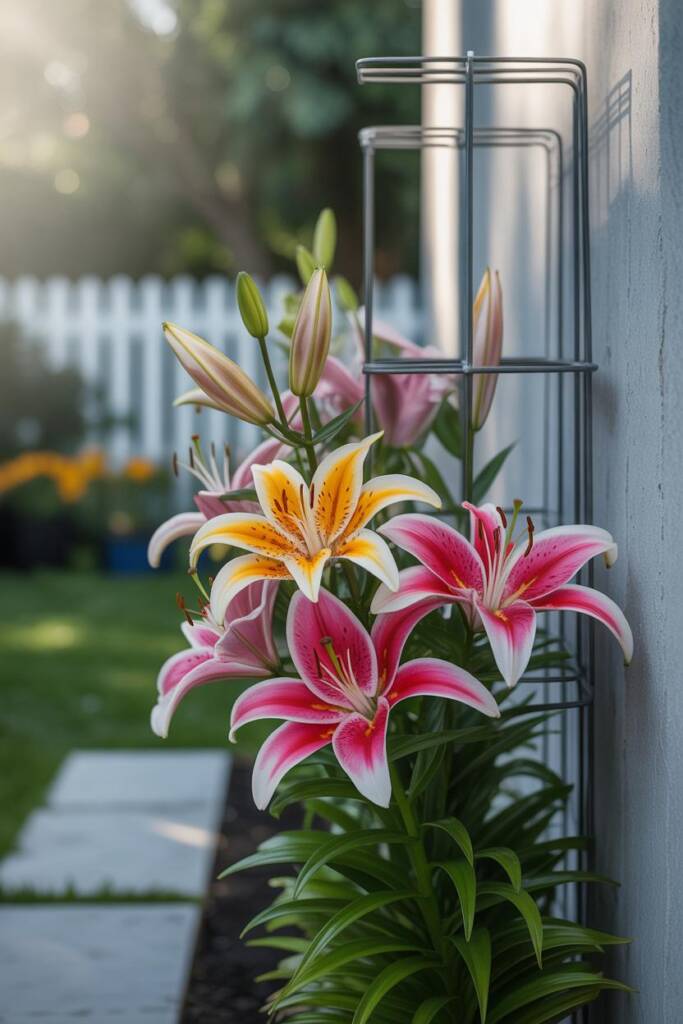
If you only remove one plant from your yard, make it lilies. Easter lilies, tiger lilies, Asiatic lilies, and daylilies are all extraordinarily toxic to cats—and we’re talking about a true emergency situation. Just brushing against the flower and getting pollen on their fur, then grooming it off, can trigger acute kidney failure. A tiny nibble of a leaf or petal can be fatal within 24-72 hours if untreated.
The scary part? Lilies are everywhere. They’re gifted for holidays, planted in spring flower beds, and featured in bouquets. Symptoms start with vomiting and lethargy within hours, progressing to decreased urination and complete kidney shutdown. There’s a narrow window for treatment—immediate veterinary care is crucial.
Safe swap: Plant roses, snapdragons, or zinnias instead. They offer the same dramatic garden impact with gorgeous blooms, but won’t harm your cat if they decide to investigate. Gerber daisies also create stunning color without the danger.
2. Azaleas and Rhododendrons: Gorgeous But Deadly
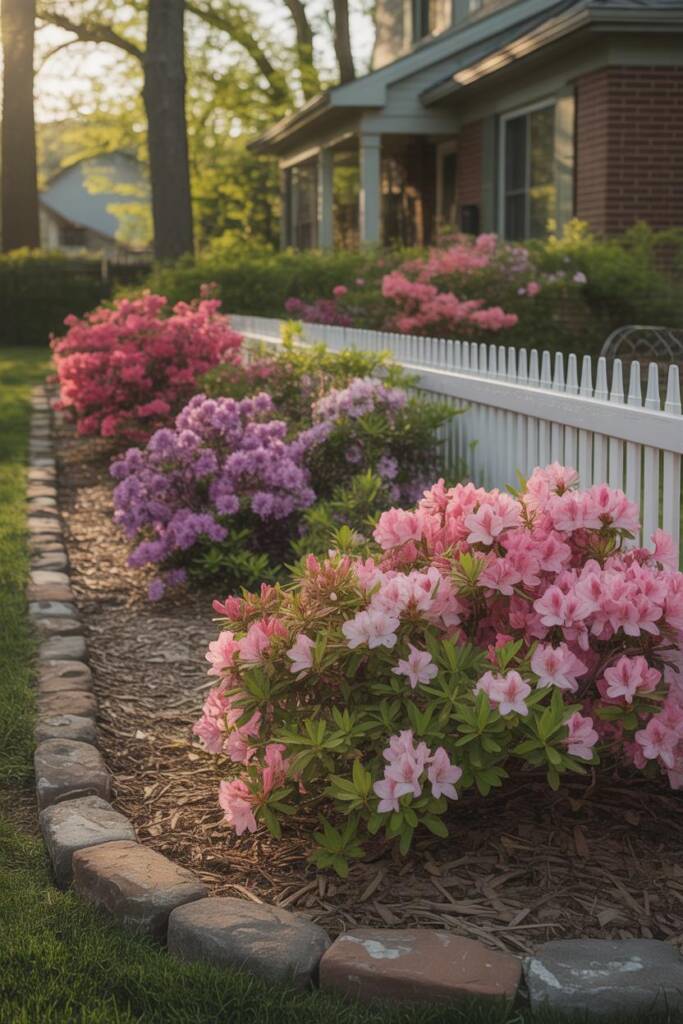
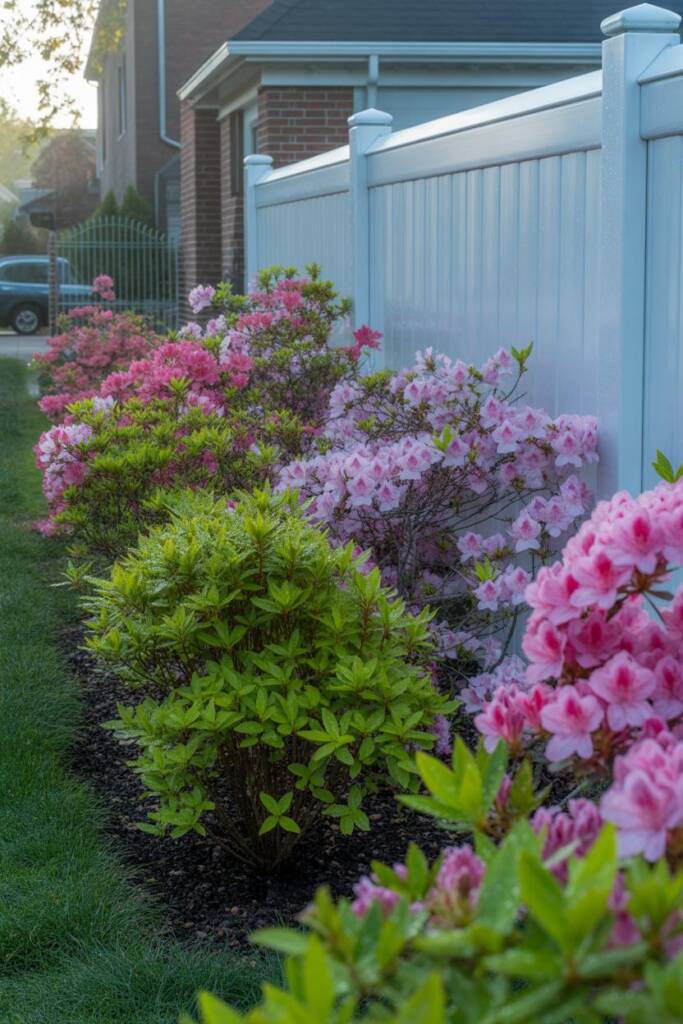
These spring-blooming shrubs are landscaping staples, lining walkways and foundation plantings across neighborhoods. They’re so common that you probably don’t give them a second thought—but you should. Azaleas and rhododendrons contain grayanotoxins that affect the heart, muscles, and nervous system. Even a few leaves can cause serious problems.
Cats might be attracted to these plants because the leaves stay green year-round, and outdoor cats sometimes nibble greenery for digestive purposes. Within hours of ingestion, you’ll notice drooling, vomiting, diarrhea, and weakness. Severe cases lead to heart arrhythmias, seizures, and coma. The toxins are present in every part of the plant, including the nectar.
Safe swap: Try camellias, which offer similar evergreen foliage and beautiful blooms, or plant butterfly bush for that same lush, flowering shrub effect. Both are completely non-toxic to cats and attract pollinators to your garden.
3. Sago Palm: A Tropical Look with Catastrophic Consequences
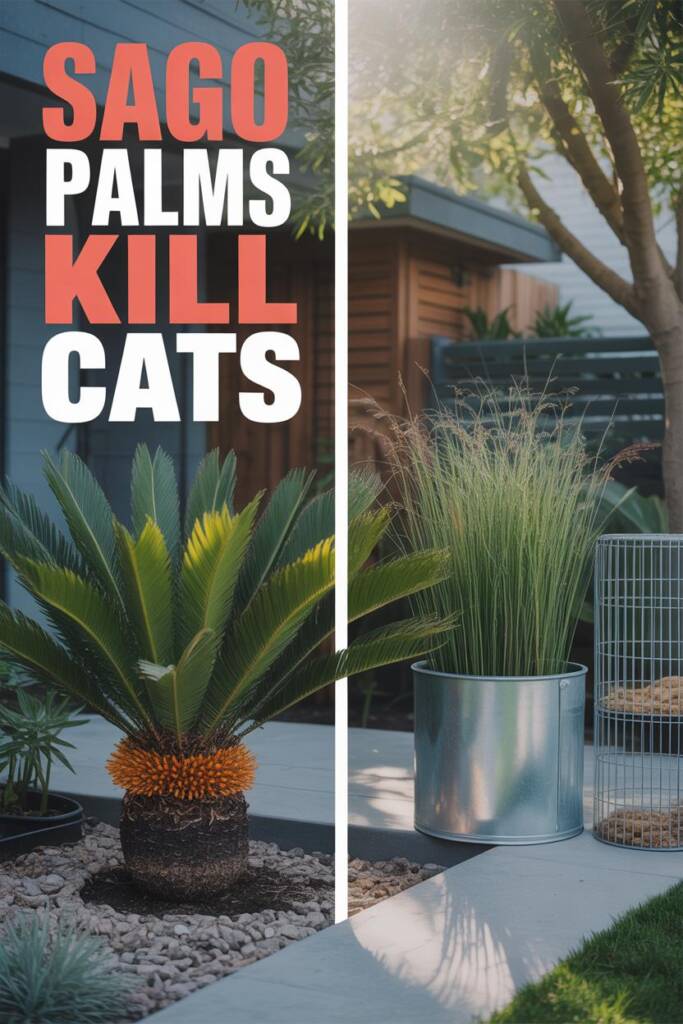
Despite the name, sago palms aren’t true palms—they’re ancient cycads that give yards that trendy tropical aesthetic. They’re low-maintenance, drought-tolerant, and increasingly popular in modern landscaping. They’re also one of the most poisonous plants you can have around cats. Every single part contains cycasin, with the highest concentration in the seeds.
The terrifying reality: ingesting even one or two seeds can cause severe liver failure (toxic for dogs too). Symptoms start with vomiting and diarrhea within 15 minutes to several hours, followed by liver damage, neurological symptoms, and seizures. The mortality rate is high even with aggressive treatment. Cats might be attracted to the seeds that drop on the ground or dig around the base out of curiosity.
Safe swap: For that palm-like tropical vibe, choose true palms like areca palm or parlor palm (verify they’re cat-safe varieties), or use ornamental grasses like maiden grass that create similar texture and movement without the danger.
4. Tulips and Daffodils: Spring Bulbs with a Bitter Secret
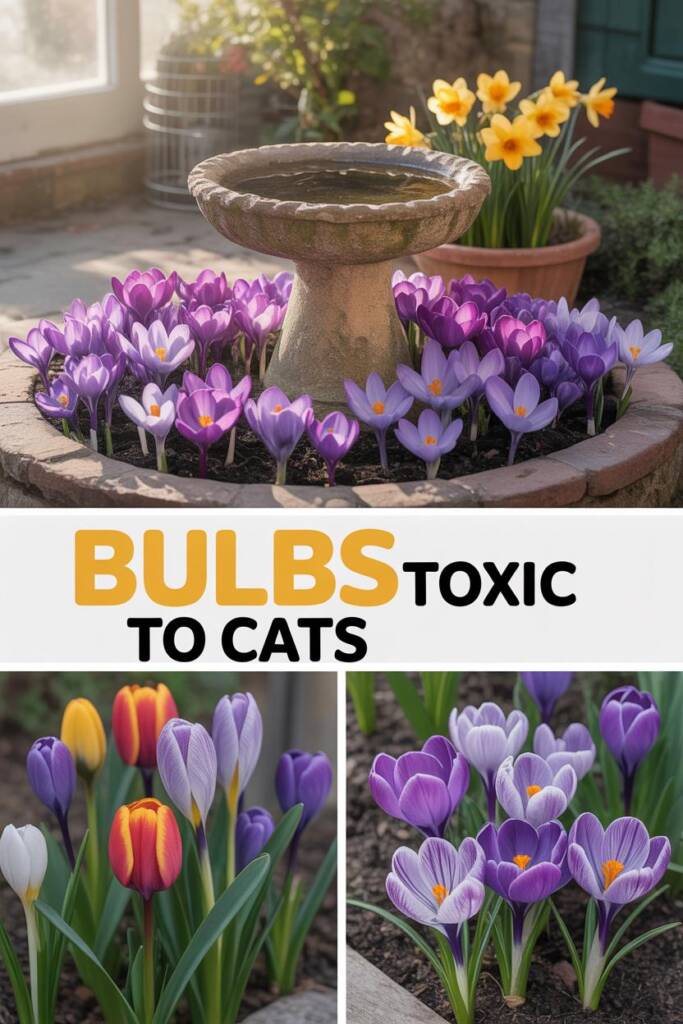
These cheerful spring bloomers signal the end of winter and brighten up garden beds everywhere. The problem? The bulbs contain the highest concentration of toxins—and cats who dig or play in garden beds can uncover them. Squirrels often dig up and scatter bulbs too, leaving them exposed where curious cats find them.
Tulip and daffodil bulbs contain compounds that cause intense gastrointestinal upset, drooling, and even heart problems in higher doses. Daffodils are particularly dangerous because they contain lycorine, which affects the heart and can cause arrhythmias. Most poisonings happen in fall during planting season or early spring when shoots emerge, and cats investigate the fresh growth.
Safe swap: Plant crocus (spring variety, NOT autumn crocus), violets, or petunias. These early bloomers provide the same pop of spring color without putting your cat at risk. You can also use planters for bulbs, elevated where cats can’t access them.
5. Autumn Crocus: The Fall Bloomer That’s Not Worth the Risk
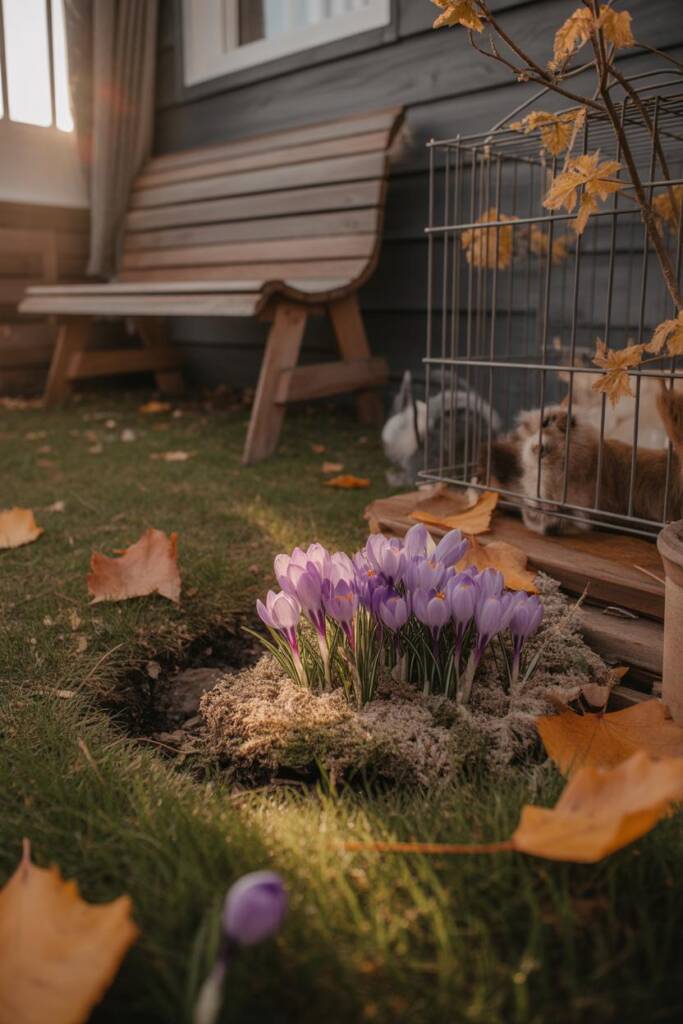
Don’t confuse this with the safe spring crocus—autumn crocus (also called meadow saffron) is an entirely different plant that blooms in late summer and fall. It’s beloved for adding unexpected color when most gardens are winding down, but it contains colchicine, an extremely toxic alkaloid that affects multiple organ systems simultaneously.
What makes autumn crocus particularly insidious is that symptoms can be delayed for hours or even days after ingestion, making it harder to connect the dots. Initial signs include vomiting, diarrhea, and abdominal pain, but the real damage happens internally—bone marrow suppression, liver and kidney failure, and respiratory distress can follow. There’s no antidote for colchicine poisoning, and treatment is purely supportive, hoping the cat’s body can process the toxin.
Safe swap: Asters and sedum provide beautiful fall blooms without the danger. Ornamental kale also adds stunning color to autumn gardens and is completely safe if your cat decides to take a nibble.
6. Oleander: The Privacy Hedge That’s Hiding a Dark Secret
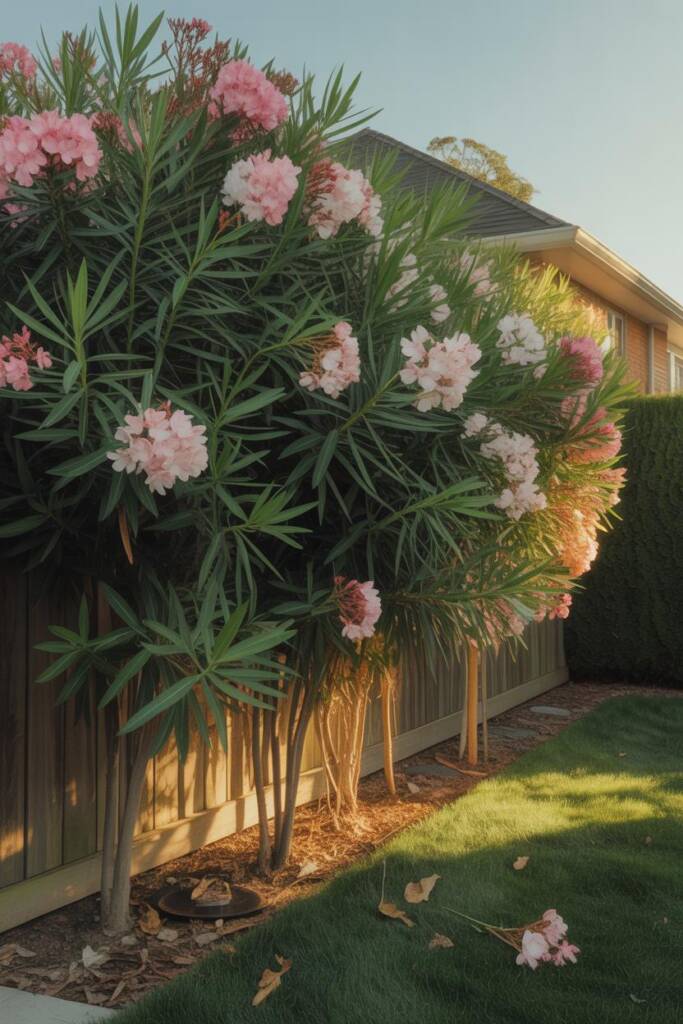
Oleander is everywhere in warmer climates—lining highways, used as property dividers, and planted for privacy screening. Its evergreen foliage and clusters of pink, white, or red flowers make it a landscaper’s dream. But it’s a cat owner’s nightmare. Every part of oleander contains cardiac glycosides that affect heart function, similar to digitalis.
Here’s what most people don’t realize: even dead, dried leaves are toxic. Burning oleander trimmings releases toxic smoke. A single leaf can be fatal to a cat. Symptoms include drooling, vomiting, abnormal heart rate, tremors, and seizures. Because oleander is often used as a hedge, cats walk through it, brush against it, and get sap or residue on their fur—then ingest it during grooming.
Safe swap: For privacy hedges, consider boxwood, privet (Japanese privet is safer than others), or forsythia. Bamboo screening also creates excellent privacy and grows quickly without poisoning your pets.
7. Castor Bean Plant: Architectural Drama with Deadly Seeds
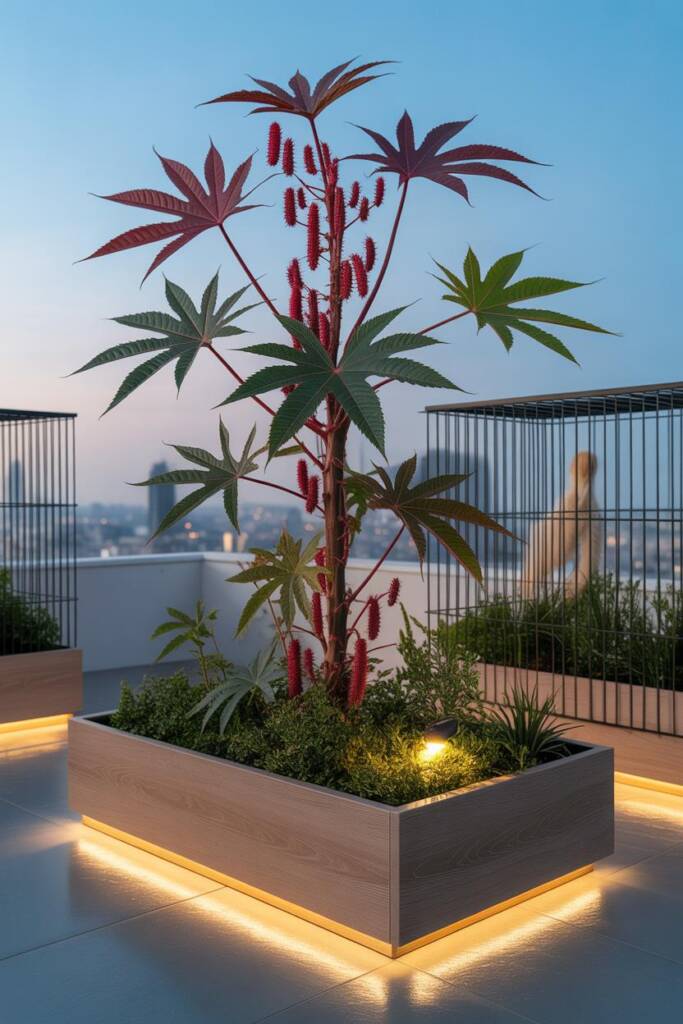
Castor bean plants have made a comeback in trendy garden design thanks to their bold, tropical-looking foliage and impressive height. They create instant drama and fill vertical space beautifully. Unfortunately, they contain ricin—one of the most toxic naturally occurring substances on earth. The seeds are especially concentrated with this poison.
The danger multiplies because castor bean plants self-seed aggressively, spreading throughout your yard. Cats investigating new growth or batting at the interesting seed pods can accidentally ingest them. Even chewing on a single seed can release enough ricin to cause severe poisoning. Symptoms include severe abdominal pain, vomiting, diarrhea (often bloody), seizures, and organ failure. Ricin damages cells throughout the body, and there’s no antidote.
Safe swap: For that tall, architectural impact, try canna lilies (true cannas, not calla lilies), elephant ears (Colocasia – verify variety), or Joe Pye weed. These give you dramatic height and bold foliage without the life-threatening risks.
8. Kalanchoe: The Succulent That’s Not as Harmless as It Looks
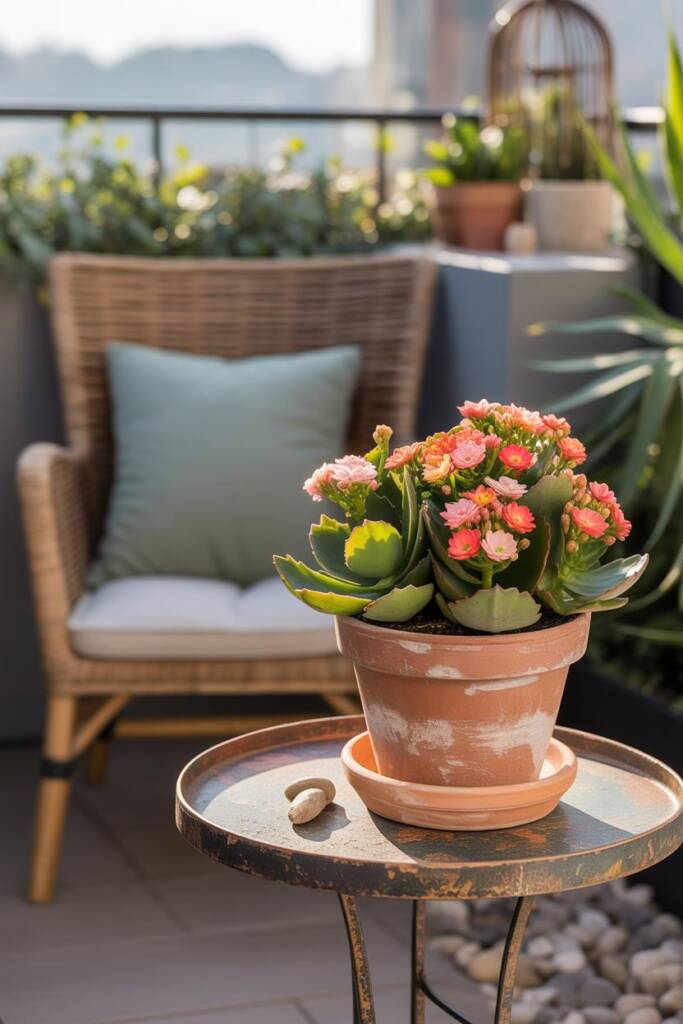
Succulents have exploded in popularity, and kalanchoe is a garden center favorite for rock gardens, containers, and xeriscaping. Its colorful blooms and easy-care nature make it seem perfect for outdoor spaces. But kalanchoe contains cardiac glycosides that affect heart rhythm and function in cats—similar to oleander but in a plant that looks completely innocent.
Cats are often attracted to succulents because of their texture and the way they move in the breeze. A curious nibble seems harmless until symptoms appear: vomiting, diarrhea, and abnormal heart rhythms. In severe cases, cardiac arrest can occur. The fleshy leaves contain the highest concentration of toxins, and because the plants are usually within easy reach, cats have ample opportunity to sample them.
Safe swap: Choose echeveria, sempervivum (hens and chicks), or most sedum varieties instead. These offer the same low-water, sculptural appeal without cardiac toxins. Spider plants also work beautifully in containers and are completely cat-safe.
9. Chrysanthemums: Fall Festival Favorites That Cause More Than Sniffles
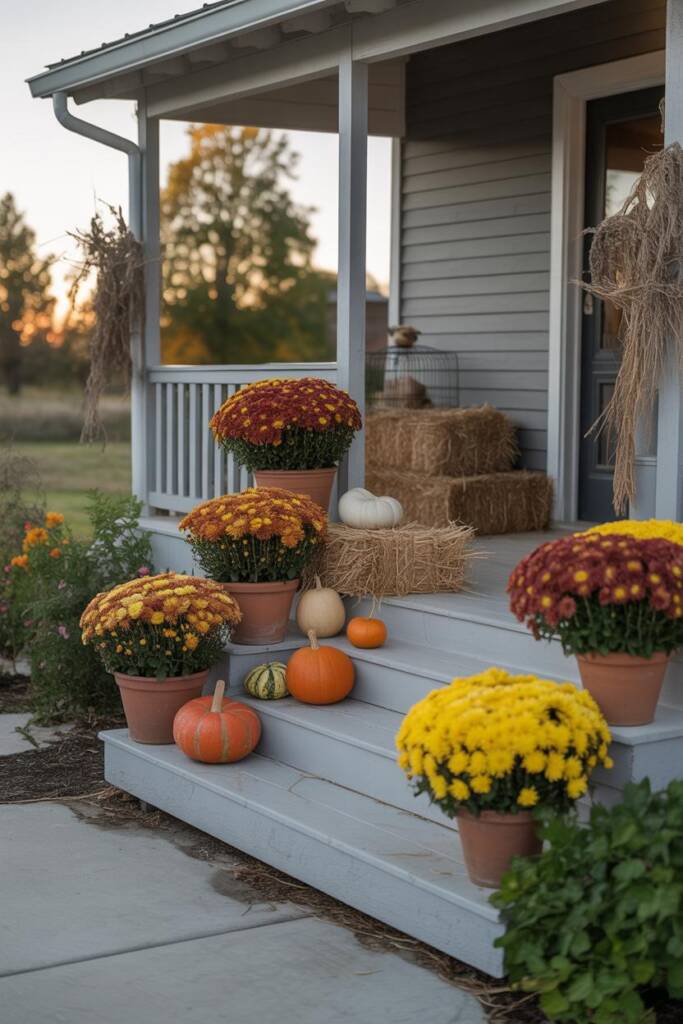
Mums are synonymous with autumn—adorning porches, filling garden beds, and creating those classic fall displays. They’re affordable, long-blooming, and come in every warm color imaginable. They also contain pyrethrins, the same compounds used in many insecticides. While generally causing mild to moderate toxicity, they can still make your cat miserable.
Symptoms include vomiting, diarrhea, drooling, loss of coordination, and dermatitis if the plant contacts their skin. Some cats are more sensitive than others, and repeated exposure can worsen reactions. Because mums are often placed right at entry points where cats pass by regularly, contact is almost inevitable.
Safe swap: Pansies, marigolds (yes, really—they’re cat-safe despite the strong smell), and celosia provide the same vibrant fall colors without the insecticide compounds. These alternatives let you keep your autumn aesthetic guilt-free.
10. Ivy: The Climbing Cover-Up for Hidden Danger
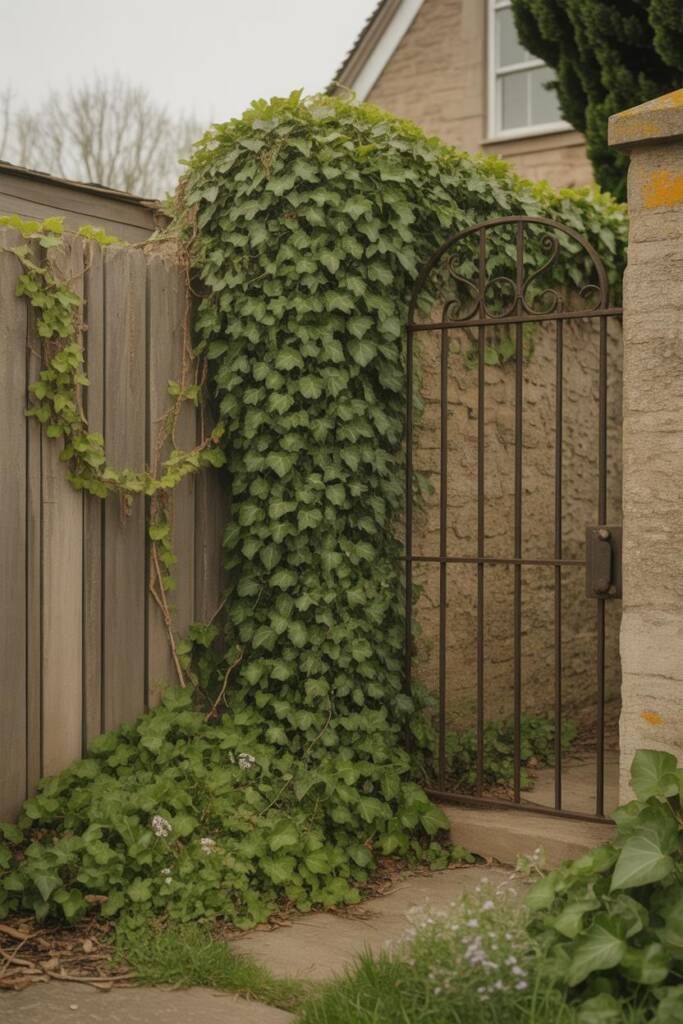
English ivy and its relatives create lush ground cover, climb walls beautifully, and stay green year-round—which is exactly why it’s everywhere. It fills bare spots under trees, covers fences, and adds that cottage garden charm. But ivy contains triterpenoid saponins that cause gastrointestinal distress and, in some cases, more serious symptoms.
The problem with ivy is its ubiquity. It’s not just where you planted it—ivy spreads aggressively, climbing trees, covering ground, and showing up in unexpected places throughout your yard. Cats walking through ivy patches or climbing ivy-covered surfaces get sap on their paws and fur. Ingestion causes vomiting, diarrhea, drooling, and abdominal pain. Some cats also develop skin irritation from contact.
Safe swap: For ground cover, use creeping thyme, sweet woodruff, or ajuga. For climbing interest, train climbing roses, jasmine (true jasmine, not Carolina jessamine), or honeysuckle—all safer options that still provide the coverage you want.
Creating Your Cat-Safe Outdoor Haven
Now that you know the culprits, it’s time for action. Walk your yard with this list and a smartphone—photograph anything you’re unsure about and use a plant identification app to confirm what you have. Mark toxic plants with stakes or flags so you know what needs to go. Don’t forget to check neighboring yards too; cats don’t respect property lines, and that oleander hedge next door is just as dangerous.
Consider creating dedicated “cat zones” with catnip, cat grass, and cat-safe plants that encourage your feline to stay in safer areas. Container gardening lets you keep questionable plants elevated and inaccessible.
If you’re attached to a toxic plant, relocate it to a fenced area your cat can’t access, or replace it gradually with safe alternatives. Your yard can still be gorgeous—it just needs to be intentionally designed with your cat’s safety in mind.
Warning Signs That Demand Immediate Action
Time is everything when it comes to plant poisoning. Watch for sudden vomiting, excessive drooling, diarrhea, lack of appetite, or lethargy after your cat has been outside. More severe symptoms include difficulty breathing, abnormal heart rate, weakness, tremors, seizures, or collapse. Some toxins cause symptoms within minutes; others take hours or days.
If you suspect your cat ingested a toxic plant, don’t wait to see if symptoms develop—call your vet or pet poison control immediately. If possible, identify which plant they encountered and bring a sample or clear photo with you to the emergency vet. Never try to induce vomiting without veterinary guidance, as this can sometimes make things worse depending on the toxin involved.
Cat-Safe Garden Makeover Essentials
- Plant Identification App (Free: PlantNet, PictureThis) – Before you remove anything, know exactly what you’re dealing with. These apps let you photograph plants and get instant identification, helping you distinguish between safe and toxic varieties that look similar.
- Heavy-Duty Garden Gloves – Protect yourself while removing toxic plants. Many of these plants can cause skin irritation in humans too, especially oleander and castor bean. Quality gloves make the job safer and more comfortable.
- Cat Grass Growing Kit – Give your cat something safe to nibble. These kits provide an alternative for cats who like to munch on greenery, redirecting them away from potentially dangerous plants. They’re easy to grow and can be placed in outdoor areas your cat frequents.
- Landscape Fabric or Mulch – After removing toxic plants, prevent regrowth with landscape fabric and cover with decorative mulch. This is especially important for ivy and other aggressive spreaders that try to return from underground roots.
- Pet-Safe Garden Fence Sections – Create barriers around any plants you can’t immediately remove or separate cat zones from areas under renovation. Short decorative fencing keeps curious cats away from danger zones while you complete your garden transformation.
Your Cat Deserves a Safe Space to Explore
Your yard should be a place where your cat can safely enjoy sunshine, chase bugs, and satisfy their natural curiosity—not a minefield of toxic threats. By identifying and removing these ten common poisonous plants, you’re creating an environment where outdoor time means joy, not danger. Share this information with neighbors who have cats too; community awareness keeps more felines safe.
Making these changes shows the kind of thoughtful care that every pet deserves. For more ideas on creating the perfect environment for your pets and home, Sweet Purrfections is your go-to resource. We’re all about practical solutions that help pet lovers and home lovers create spaces where everyone thrives—furry family members included.
Meet Sean, a fintech whiz with a penchant for pet purrs and blockchain buzz. After a decade of fintech feats, Sean’s tech talents leaped from ledger lines to litter lines, driven by a passion for pets and a vision for a more connected pet care community. With three critter companions as co-pilots, Sean launched this blog to share a treasury of pet-friendly tech tips and tales.



Leave a Reply